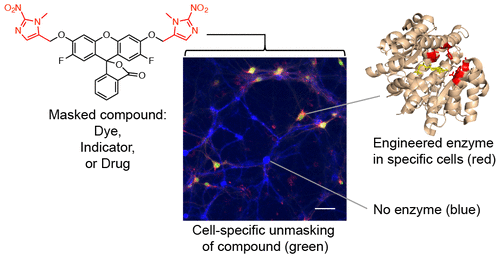当前位置:
X-MOL 学术
›
ACS Chem. Biol.
›
论文详情
Our official English website, www.x-mol.net, welcomes your
feedback! (Note: you will need to create a separate account there.)
Cell-Specific Chemical Delivery Using a Selective Nitroreductase–Nitroaryl Pair
ACS Chemical Biology ( IF 3.5 ) Pub Date : 2018-08-16 00:00:00 , DOI: 10.1021/acschembio.8b00524 Todd D Gruber 1 , Chithra Krishnamurthy 1, 2 , Jonathan B Grimm 1 , Michael R Tadross 1 , Laura M Wysocki 1 , Zev J Gartner 2 , Luke D Lavis 1
ACS Chemical Biology ( IF 3.5 ) Pub Date : 2018-08-16 00:00:00 , DOI: 10.1021/acschembio.8b00524 Todd D Gruber 1 , Chithra Krishnamurthy 1, 2 , Jonathan B Grimm 1 , Michael R Tadross 1 , Laura M Wysocki 1 , Zev J Gartner 2 , Luke D Lavis 1
Affiliation

|
The utility of small molecules to probe or perturb biological systems is limited by the lack of cell-specificity. “Masking” the activity of small molecules using a general chemical modification and “unmasking” it only within target cells overcomes this limitation. To this end, we have developed a selective enzyme–substrate pair consisting of engineered variants of E. coli nitroreductase (NTR) and a 2-nitro-N-methylimidazolyl (NM) masking group. To discover and optimize this NTR–NM system, we synthesized a series of fluorogenic substrates containing different nitroaromatic masking groups, confirmed their stability in cells, and identified the best substrate for NTR. We then engineered the enzyme for improved activity in mammalian cells, ultimately yielding an enzyme variant (enhanced NTR, or eNTR) that possesses up to 100-fold increased activity over wild-type NTR. These improved NTR enzymes combined with the optimal NM masking group enable rapid, selective unmasking of dyes, indicators, and drugs to genetically defined populations of cells.
中文翻译:

使用选择性硝基还原酶-硝基芳基对进行细胞特异性化学递送
小分子探测或干扰生物系统的效用因缺乏细胞特异性而受到限制。使用一般化学修饰“掩盖”小分子的活性并仅在靶细胞内“揭开”它克服了这一限制。为此,我们开发了一种选择性酶-底物对,由大肠杆菌硝基还原酶 (NTR) 的工程变体和 2-硝基-N-甲基咪唑基 (NM) 掩蔽基团组成。为了发现和优化这个NTR-NM系统,我们合成了一系列含有不同硝基芳香族掩蔽基团的荧光底物,确认了它们在细胞中的稳定性,并确定了NTR的最佳底物。然后,我们对这种酶进行了改造,以提高哺乳动物细胞中的活性,最终产生了一种酶变体(增强型 NTR 或 eNTR),其活性比野生型 NTR 提高了 100 倍。这些改进的 NTR 酶与最佳的 NM 掩蔽基团相结合,能够快速、选择性地对基因定义的细胞群进行染料、指示剂和药物的掩蔽。
更新日期:2018-08-16
中文翻译:

使用选择性硝基还原酶-硝基芳基对进行细胞特异性化学递送
小分子探测或干扰生物系统的效用因缺乏细胞特异性而受到限制。使用一般化学修饰“掩盖”小分子的活性并仅在靶细胞内“揭开”它克服了这一限制。为此,我们开发了一种选择性酶-底物对,由大肠杆菌硝基还原酶 (NTR) 的工程变体和 2-硝基-N-甲基咪唑基 (NM) 掩蔽基团组成。为了发现和优化这个NTR-NM系统,我们合成了一系列含有不同硝基芳香族掩蔽基团的荧光底物,确认了它们在细胞中的稳定性,并确定了NTR的最佳底物。然后,我们对这种酶进行了改造,以提高哺乳动物细胞中的活性,最终产生了一种酶变体(增强型 NTR 或 eNTR),其活性比野生型 NTR 提高了 100 倍。这些改进的 NTR 酶与最佳的 NM 掩蔽基团相结合,能够快速、选择性地对基因定义的细胞群进行染料、指示剂和药物的掩蔽。










































 京公网安备 11010802027423号
京公网安备 11010802027423号